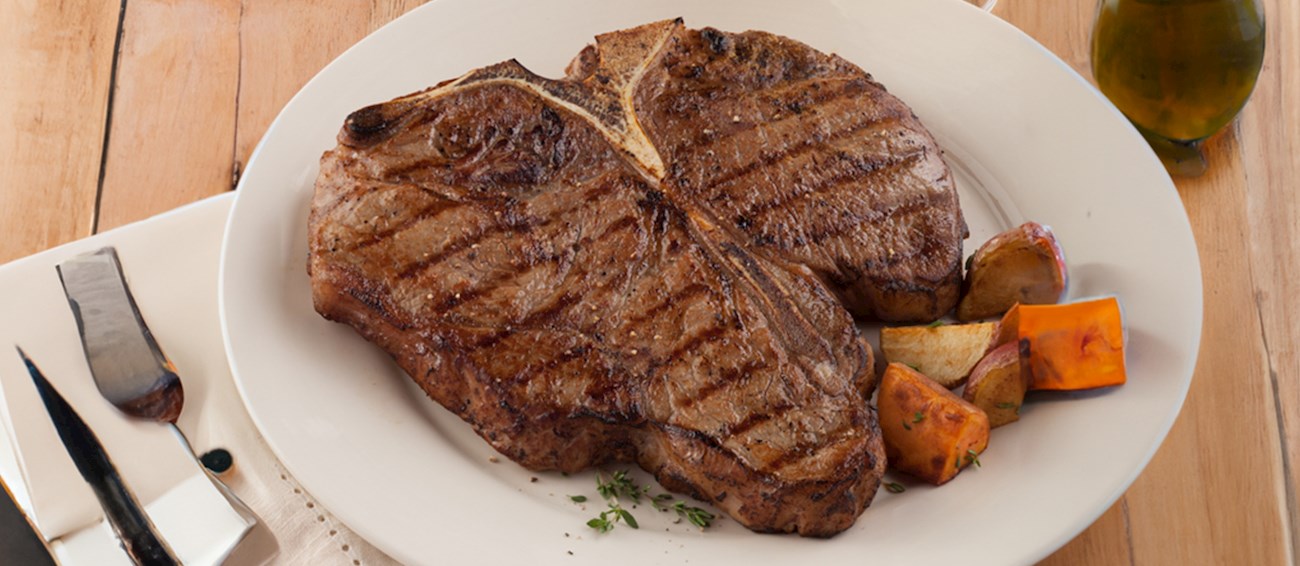MAIN INGREDIENTS
Entrecôte is a type of beef steak that's cut from between the ribs, but it's more commonly known as a thin and boneless rib-eye steak. The butchers cut bone-in rib-eyes with the bone on each side, but there are also six leftover boneless steaks from the meat between each bone-in rib-eye, and they're known as the entrecôtes.
Due to the fact that these cuts are thin, it makes them great for quick cooking on the grill or in a pan (high heat), but it's important not to overcook them. The steaks are juicy, tender, and generously marbled. This type of meat cut is popular in France and Europe, and the word entrecôte means between the ribs.
VARIATIONS OF Ribeye
MAIN INGREDIENTS
A porterhouse steak is a large, thick cut of beef taken from the rear end of the short loin.
Although it is not linked to a specific country of origin, it is most commonly associated with British and American cuisines. It is named "porterhouse" because it was traditionally served in 18th-century porterhouses, which were inns or restaurants that served porter beer.
MAIN INGREDIENTS
Created between 1840 and 1850, the Delmonico steak is a mystery that perplexes many. What you order in one restaurant may be different in another. Various food critics and food historians have come up with more than several differing opinions about this steak, and whether it is bone-in or -out, sirloin, or some other high-priced cut of beef.
Moreover, while the two original chefs de cuisine of Delmonico Restaurant in New York City have both confirmed the preparation method, they still manage to differ slightly. If you order a Delmonico steak at Delmonico's today, you'll get a boneless rib-eye steak that's brushed with butter and beef fat after it has been taken out of the broiler.
T-bone steak is a popular cut of beef that comes from the short loin section of the cow. It is easily recognizable by the T-shaped bone that runs through the center of the steak, dividing two different cuts of meat. On one side of the bone is the New York strip (or striploin), known for its balance of flavor and tenderness.
On the other side is a small portion of the tenderloin (or filet mignon), which is incredibly tender but less flavorful than the strip side. The T-bone steak is prized for offering both of these cuts in one piece, providing a combination of tenderness and flavor in a single steak.
MAIN INGREDIENTS
Burnt ends are a delicious specialty originating from Kansas City. The name refers to the unusually-shaped, tougher, fattier end pieces of barbecued brisket which were served as appetizers, placed into stews, or given to customers free of charge.
These smoky burnt ends capture melted fat during the barbecue process, making them incredibly flavorful. Nowadays, they are a staple menu item in the city, usually served cubed on their own or smothered in barbecue sauce. Burnt ends can also be used in sandwiches or combined with baked beans and french fries.
MOST ICONIC Burnt Ends
View moreA variety of foods might be included in a surf and turf, but traditionally, it is an entrée that includes both a portion of meat and a portion of seafood. The meat is usually a steak, while the seafood might be anything from lobster to shrimps or prawns.
The origins of surf and turf are hard to pinpoint, but steak and seafood meals became popular throughout the United States during the 1960s. The meat is typically grilled and served with an accompanying thick sauce, while the seafood is usually grilled, fried, baked, or boiled, depending on the choice of seafood.
MOST ICONIC Surf and Turf
View moreMAIN INGREDIENTS
Pit beef is an American barbecue technique originating from Maryland. The technique features beef, usually top round, that's grilled quickly over charcoal, becoming crusty on the exterior while remaining succulent and almost rare on the inside.
The meat is later sliced into thin strips and often used as a sandwich stuffing, preferably on Kaiser rolls or rye bread. The sauce for Maryland pit beef contains horseradish instead of the usual barbecue sauces based on ketchup, vinegar, and brown sugar.
It is believed that pit beef first started gaining popularity in the 1970s in Baltimore's working-class neighborhoods.
Korean galbi includes various dishes made with beef short ribs, and this version differs in the specific cut of meat. Unlike the traditional galbi in which the ribs are sliced along the bones (also known as the English cut), in L.A. galbi, the ribs are cut across the bones into thin strips.
The ribs should be marinated, typically in different combinations of soy sauce, onions, and Asian pears, and are then grilled over charcoal. Two main theories explain the origin and the name of L.A. galbi. While the less popular claims that the name stems from the lateral cut, it has been widely accepted that the dish initially appeared among the Korean community in Los Angles.
MOST ICONIC L.A. Galbi
View morePot roast is an American dish usually based on a tougher cut of beef that is seared in a pan and simmered in stock or its own juices. In America, the dish is also known as Yankee pot roast, referring to the fact that it's most often prepared in New England.
In a Yankee pot roast, vegetables such as carrots, onions, and potatoes are simmered together with the braised beef. The dish is basically an American variation of the French dish boeuf á la mode, brought over to New Hampshire and Maine by French immigrants.
MOST ICONIC Pot Roast
View moreMAIN INGREDIENTS
One of the staples of the Southern U.S. cuisine called chicken fried steak contains no chicken at all, contrary to what one might think upon seeing the name of the dish. It consists of a thin, breaded, and fried cut of beef that is traditionally served with a side of mashed potatoes and drizzled with cream gravy.
The dish got its name due to the fact that the method of preparation is very similar to that of fried chicken. Originally, the first recipes for batter-fried steaks had appeared in Southern cookbooks during the early 1800s. In the old days, the cut of beef was inexpensive and tough, usually round steak, but today many restaurants use more expensive cuts such as tenderloin and rib-eye.
MOST ICONIC Chicken Fried Steak
View moreTasteAtlas food rankings are based on the ratings of the TasteAtlas audience, with a series of mechanisms that recognize real users and that ignore bot, nationalist or local patriotic ratings, and give additional value to the ratings of users that the system recognizes as knowledgeable. For the “Top 17 American Beef Dishes” list until April 15, 2025, 1,024 ratings were recorded, of which 947 were recognized by the system as legitimate. TasteAtlas Rankings should not be seen as the final global conclusion about food. Their purpose is to promote excellent local foods, instill pride in traditional dishes, and arouse curiosity about dishes you haven’t tried.











